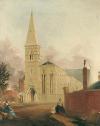History of Lynn Museum
Lynn has had a public museum since 1844. The museum opened in its present home, the Union Chapel, in 1904.

The museum was founded in 1844 by members of the Lynn Conversazione and Society of Arts who wanted 'the establishment of an institution so well calculated to improve the taste of the inhabitants of the town and neighbourhood, and particularly the rising generation; as well as to afford a source of continued amusement and gratification to those persons who had already paid attention to scientific pursuits'.
The first museum was situated in Welwick House in Union Street, but moved to the Athenaeum in 1854, a purpose-built museum and library on the site of the old Post Office in Baxters Plain.
In 1904 the museum moved a short distance to its present location, the Union Baptist Chapel. Along with the museum's collections came the fine Victorian mahogany display cases which still line the chapel walls. The new museum opened with great ceremony in 1904.
The Union Baptist Chapel was built in 1859 at a cost of £3,000 by a breakaway group from the local Baptist and Congregational churches called the Union Baptists or 'Union Splits'. The schoolroom was added in 1867.
The architect Robert Moffat Smith had designed around forty other chapels. He used an Italianate Gothic style with an exterior of white and red banded brick. He also created a fine timber roof, which was hidden behind a modern suspended ceiling until 2006. The resulting building was considerably more ornate than most non-conformist chapels. The cost of such a splendid building would be approximately £4.6 million in today's money.
"The building will be of a very ornamental character, ecclesiastical in appearance, and differing very materially from any dissenting place of worship in the town." - Lynn Advertiser, February 1859






